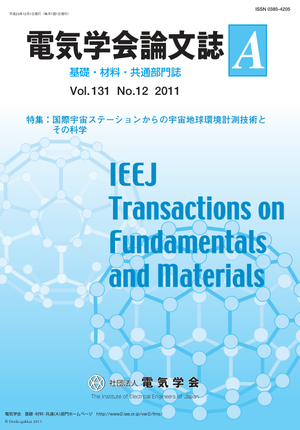Six-Channel Spectrophotometers (PH) Onboard JEM-GLIMS
Six-Channel Spectrophotometers (PH) Onboard JEM-GLIMS
カテゴリ: 論文誌(論文単位)
グループ名: 【A】基礎・材料・共通部門
発行日: 2011/12/01
タイトル(英語): Six-Channel Spectrophotometers (PH) Onboard JEM-GLIMS
著者名: Mitsuteru Sato (Department of Cosmosciences, Hokkaido University), Yukihiro Takahashi (Department of Cosmosciences, Hokkaido University), Makoto Suzuki (Institute of Space and Astronautical Science (ISAS)/JAXA), Atsushi Yamazaki (Institute of Space and Astronautical Science (ISAS)/JAXA), Tomoo Ushio (Department of Engineering, Osaka University)
著者名(英語): Mitsuteru Sato (Department of Cosmosciences, Hokkaido University), Yukihiro Takahashi (Department of Cosmosciences, Hokkaido University), Makoto Suzuki (Institute of Space and Astronautical Science (ISAS)/JAXA), Atsushi Yamazaki (Institute of Space and Astronautical Science (ISAS)/JAXA), Tomoo Ushio (Department of Engineering, Osaka University)
キーワード: lightning,TLEs,spectrophotometer,ISS/JEM
要約(英語): Six-channel spectrophotometers (PH) are the science instruments of JEM-GLIMS to measure absolute intensity of the emission originated from lightning discharges and upper atmospheric transient luminous events (TLEs). PH unit-1 (PH-U1) consists of four spectrophotometer channels named from PH1 to PH4, while PH unit-2 (PH-U2) two spectrophotometer channels named PH5 and PH6. Optical filters of these spectrophotometers are selected to detect TLE emission lines of N2 1PG, N2 2PG, N2+ 1NG, and N2 LBH. Since the bandwidth of the optical filter of PH2, 3, 5, and 6 is 10 nm and since PH1 measures NUV emission, photomultiplier tubes with high-voltage converters are used as a photon detector. To the contrary, PH4 uses a photodiode as a photon detector because the pass-band of the optical filter is enough wide to detect transient optical emission. Though PH does not equip spatial resolution, it can acquire light curve data with a high time resolution of 50 μs with a 12-bit resolution. Thus, the combinational analysis of PH data and Lightning and Sprite Imager (LSI) data, it is possible to clarify the relationship between TLEs and their parent lightning discharges, the occurrence condition of TLEs, and the energy of the electrons which excite TLE emission.
本誌: 電気学会論文誌A(基礎・材料・共通部門誌) Vol.131 No.12 (2011) 特集:国際宇宙ステーションからの宇宙地球環境計測技術とその科学
本誌掲載ページ: 1000-1005 p
原稿種別: 論文/英語
電子版へのリンク: https://www.jstage.jst.go.jp/article/ieejfms/131/12/131_12_1000/_article/-char/ja/
受取状況を読み込めませんでした


